Query Optimization#
Abstract
- Introduction
- Transformation of Relational Expressions
- Statistical Information for Cost Estimation
- Cost-based Optimization
- Dynamic Programming for Choosing Evaluation Plans
- Nested Subqueries
- Materialized Views
- Advanced Topics in Query Optimization
Introduction#
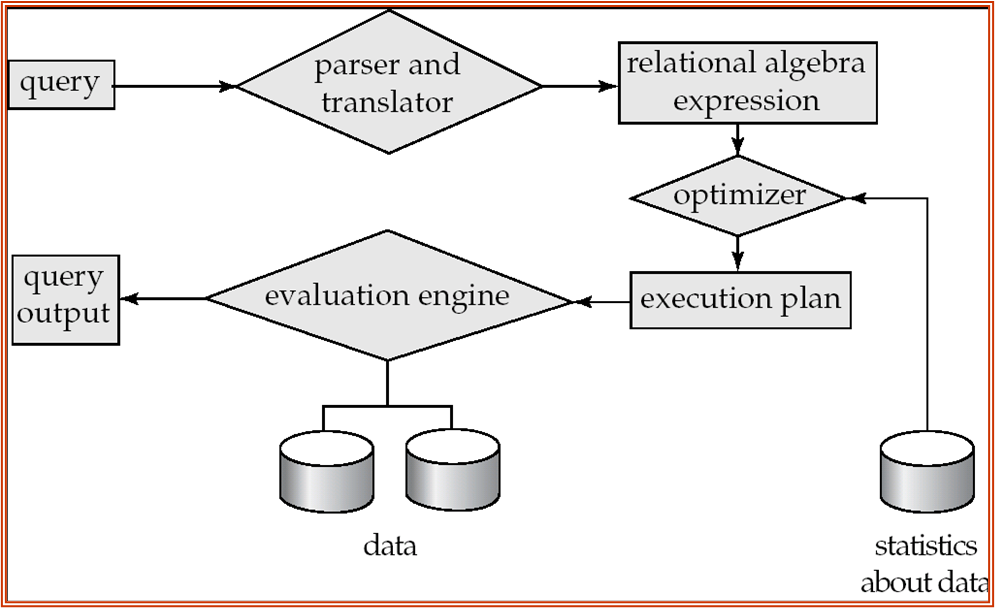
Alternative ways of evaluating a given query
- Equivalent expressions
逻辑优化:关系代数表达式(尽量先做选择,投影) - Different algorithms for each operation
物理层面:每个算子选择不同的算法
Example


Estimation of plan cost based on:
- Statistical information about relations. Examples: number of tuples, number of distinct values for an attribute
- Statistics estimation for intermediate results(Cardinality Estimation)
to compute cost of complex expressions
估计中间结果的大小
现在有基于深度学习的估计方法 - Cost formulae for algorithms, computed using statistics
关系数据库里可以用查看执行计划。
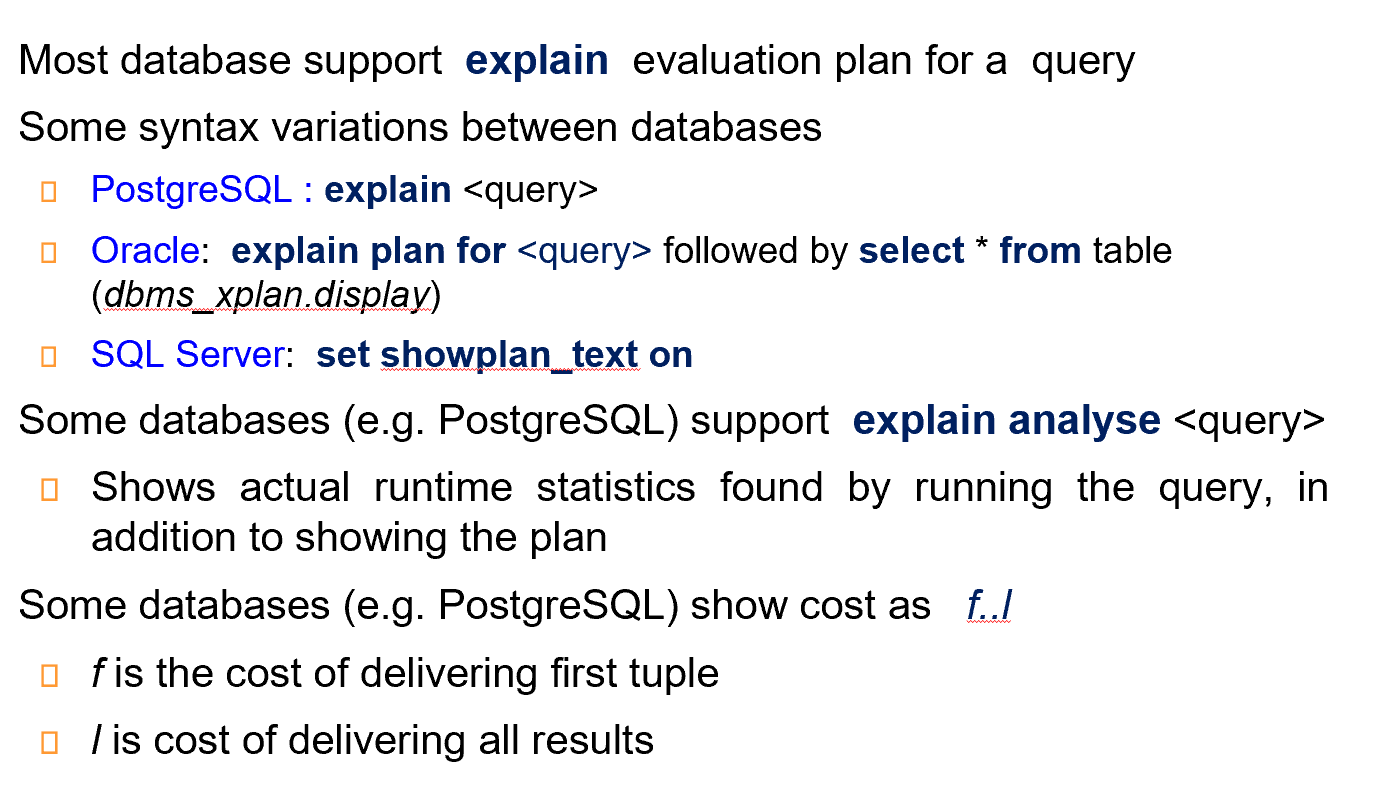
Generating Equivalent Expressions#
Two relational algebra expressions are said to be equivalent if the two expressions generate the same set of tuples on every legal database instance
形式上不一样,但是结果(输出)是一样的,产生了相同的集合。
Equivalence Rules#
-
selection

- 可以把算子拆分
如果某些属性有索引,那么可以先拆分,在索引 select 之后再执行其他算子,否则不如不拆分。 - 算子可交换
先执行有索引的算子。 - 投影的属性可以只保留最后一次的
- 选择算子可以和合并结合
- 可以把算子拆分
-
join
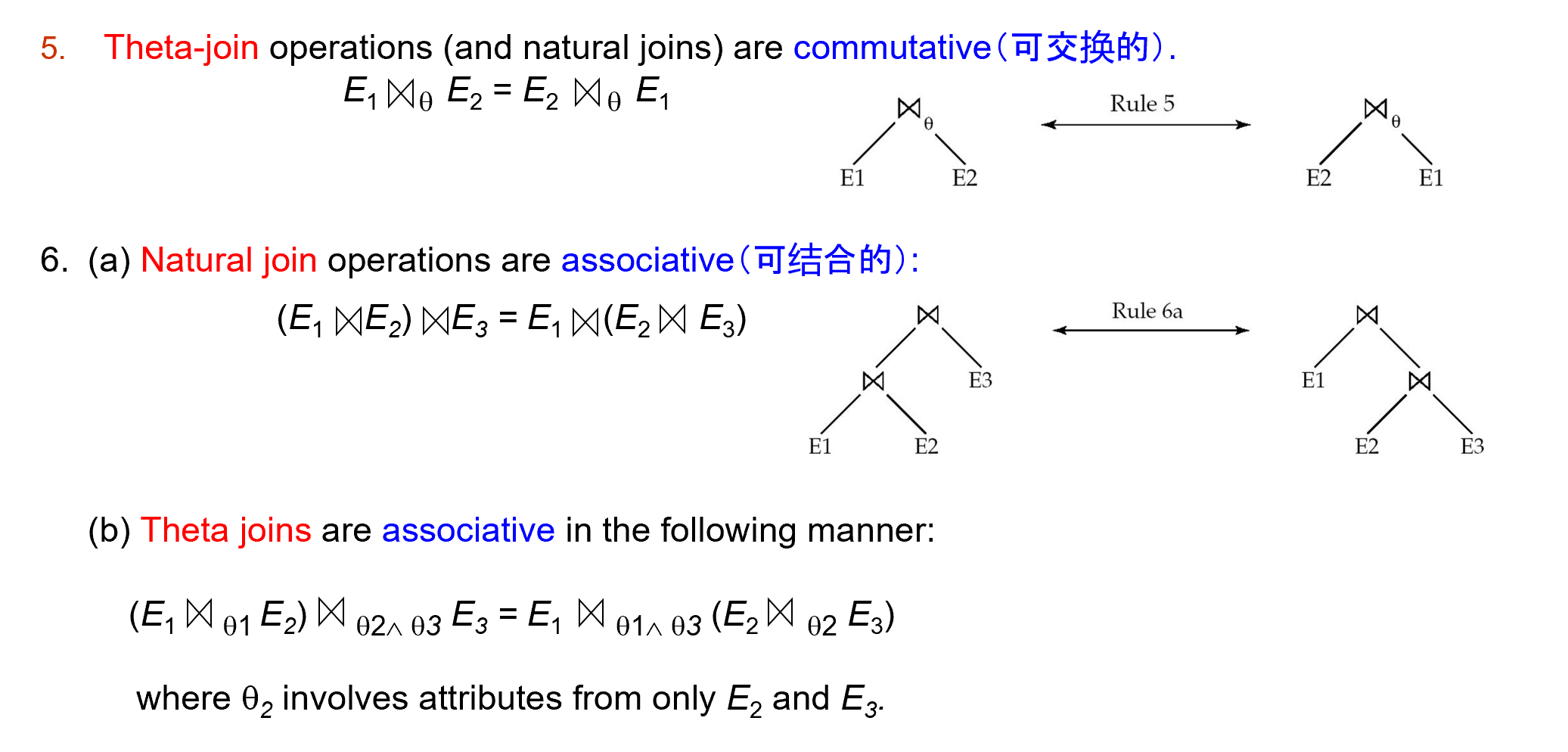
自然连接是结合的(先连接中间结果小的)
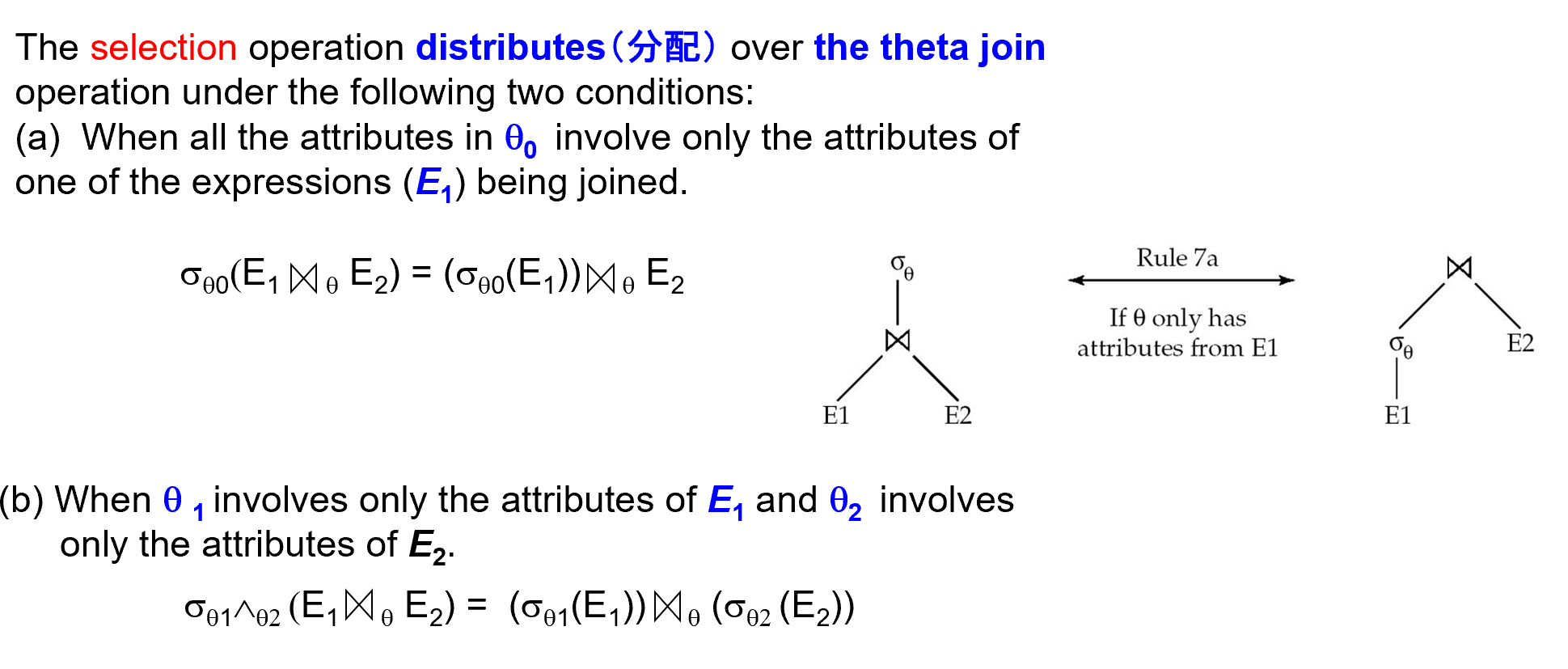
如果选择算子只和一个关系有关,那么我们可以先执行选择。(选择算子要早进行,推到叶子上)
-
projection
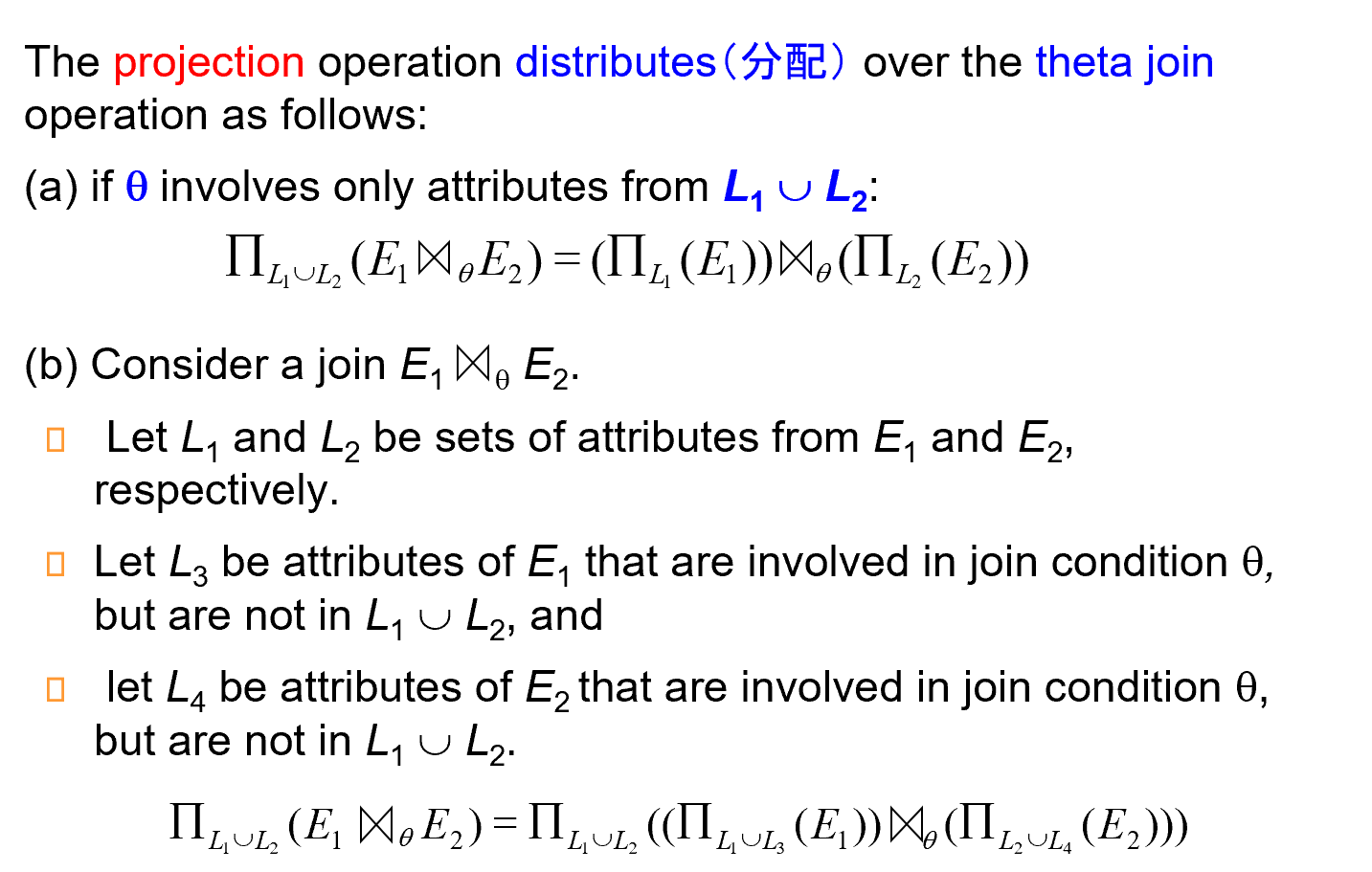
同理投影也要早做。
如果连接要用到投影后不保留的属性,我们在第一次投影时要把连接用的属性也保留下来。 -
set operation
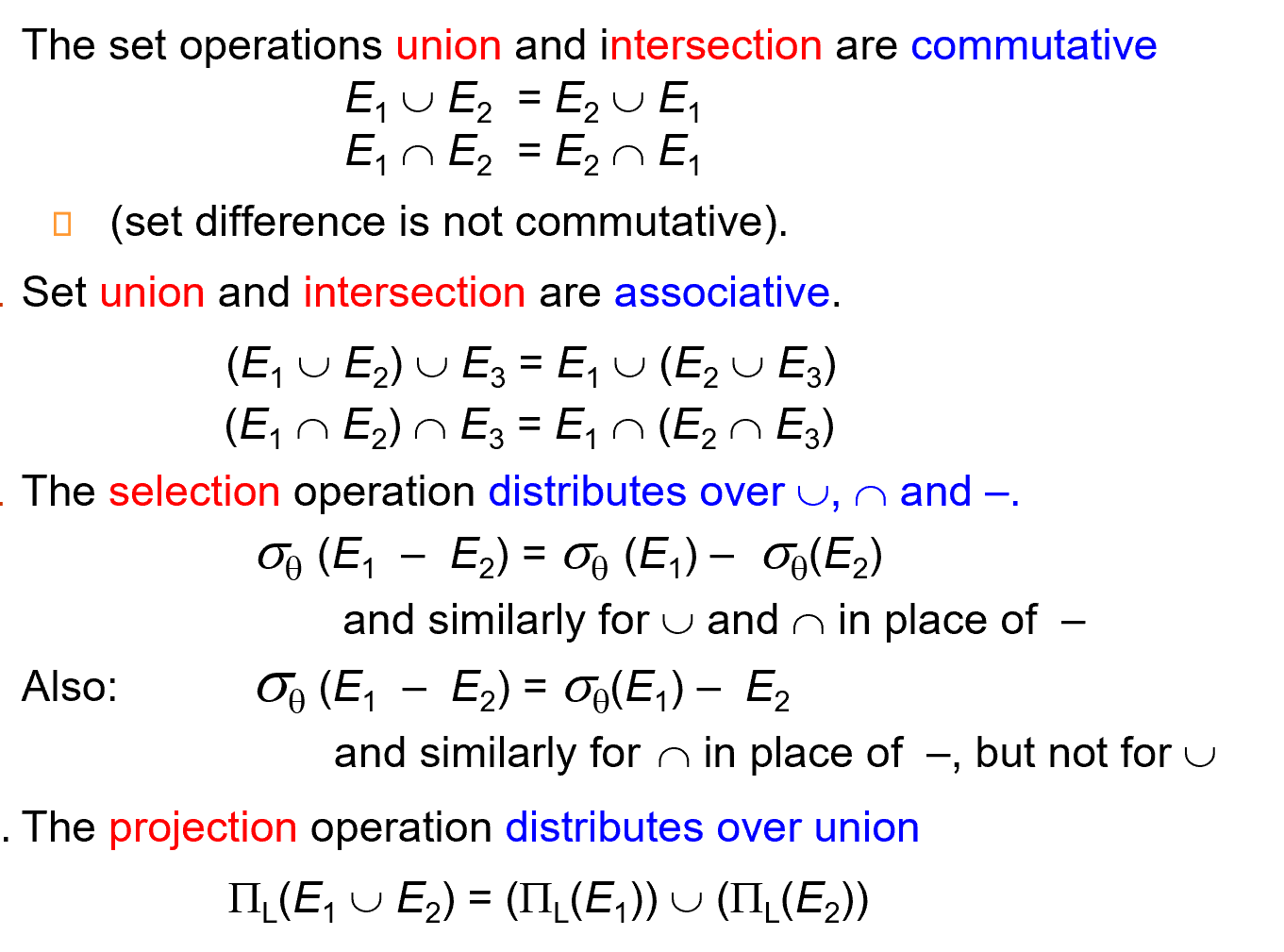
这里的减法,减数关系就不用做选择了(减去多的总是没问题的)对交集也适用
-
other

Enumeration of Equivalent Expressions#
- Repeat
- apply all applicable equivalence rules on every subexpression of every equivalent expression found so far
- add newly generated expressions to the set of equivalent expressions
- Until no new equivalent expressions are generated above
可以这样找到所有的等价表达式。
但是实际中我们基于一些经验规则进行启发式的优化
Statistics for Cost Estimation#
代价估算需要统计信息
- \(n_r\): number of tuples in a relation r.
- \(b_r\): number of blocks containing tuples of r.
- \(l_r\): size of a tuple of r.
- \(f_r\): blocking factor of r — i.e., the number of tuples of r that fit into one block.
一个块可以放多少个元组 - \(V(A, r)\): number of distinct values that appear in r for attribute A; same as the size of \(\Pi(r)\).
- If tuples of r are stored together physically in a file, then: \(b_r = \lceil \dfrac{n_r}{f_r}\rceil\)
- Histograms
attribute age of relation person

Selection Size Estimation#
中间结果
- \(\sigma_{A=v}(r)\)
\(n_r / V(A,r)\) : number of records that will satisfy the selection.
这样的估算基于值是平均分布的
如果要找的是一个 key, 那么 size estimate=1 - \(\sigma_{A\leq v}(r)\)
- Let \(c\) denote the estimated number of tuples satisfying the condition.
- \(c = 0\) if \(v < \min(A,r)\)
v 比属性 A 的最小值还要小 - \(c = n_r\cdot \dfrac{v-\min(A,r)}{\max(A,r) - \min A(A,r)}\)
- In absence of statistical information c is assumed to be \(n_r / 2\) (没有最大、最小统计信息时).

概率论。
注意这些公式的要求是条件是相互独立的。
Joins#
The Cartesian product \(r \times s\) contains \(n_r\cdot n_s\) tuples; each tuple occupies \(s_r + s_s\) bytes.
- \(R \cap S = \emptyset\)
没有公共属性,等价于 \(r\times s\) -
\(R \cap S\) is a key for \(R\), then a tuple of \(s\) will join with at most one tuple from \(r\)
Example
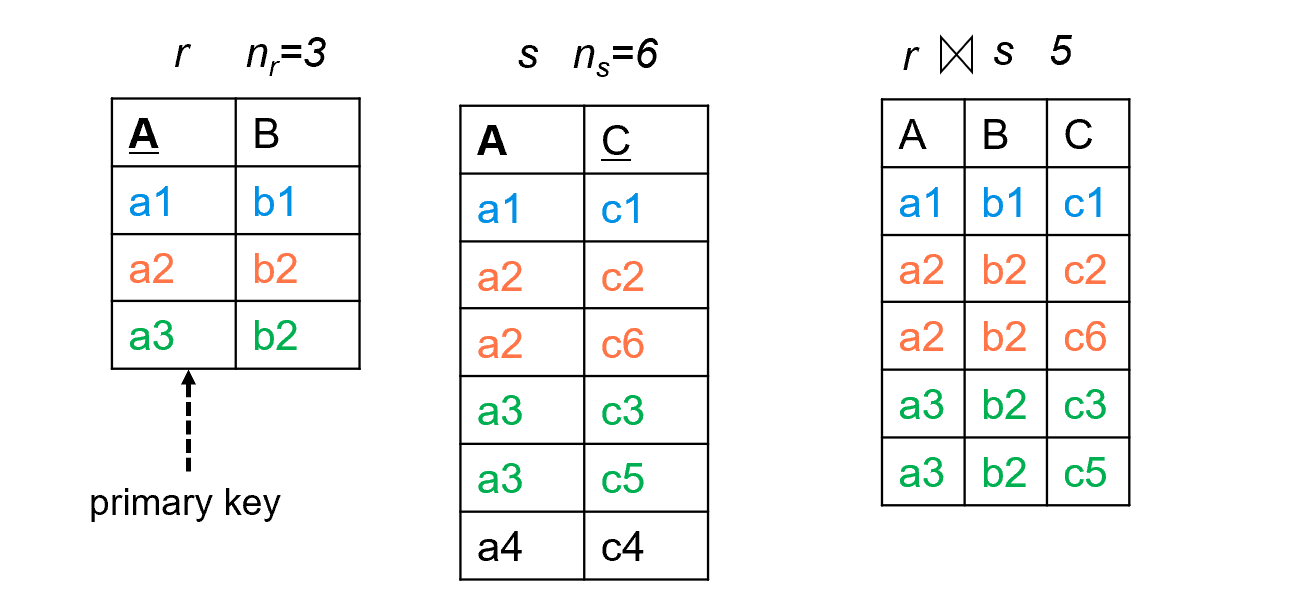
-
If \(R \cap S\) in S is a foreign key in S referencing R, then the number of tuples in \(r\bowtie s\) = the number of tuples in s.
-
If \(R \cap S = \{A\}\) is not a key for R or S.
\(n_r * \dfrac{n_s}{V(A,s)}, n_s * \dfrac{n_r}{V(A,r)}\).
以第二个为例子,站在 s 的角度,每一个 s 可以和这么多个元素连接。
通常我们取二者中的较小值。Example
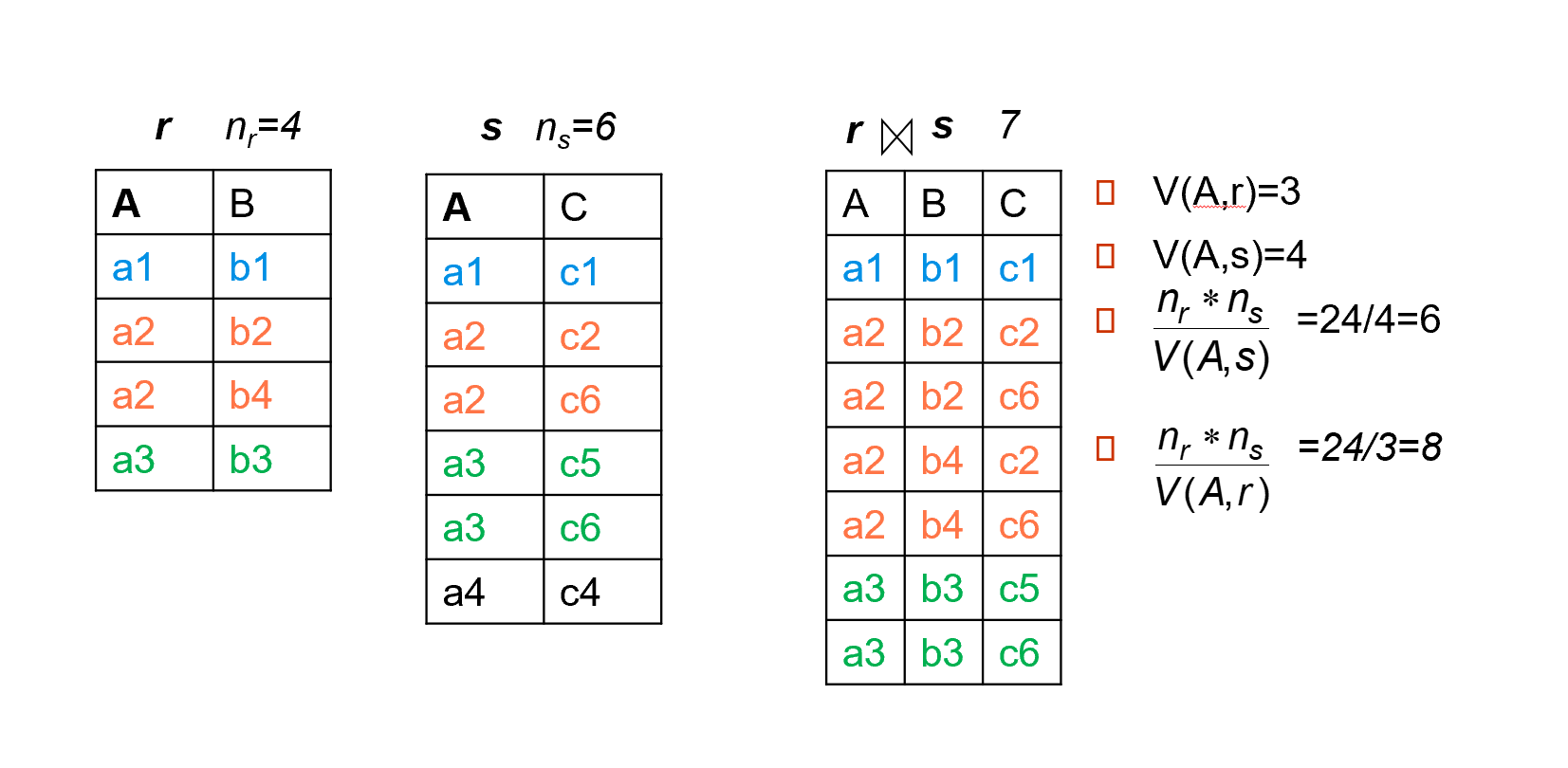
Size Estimation for Other Operations#
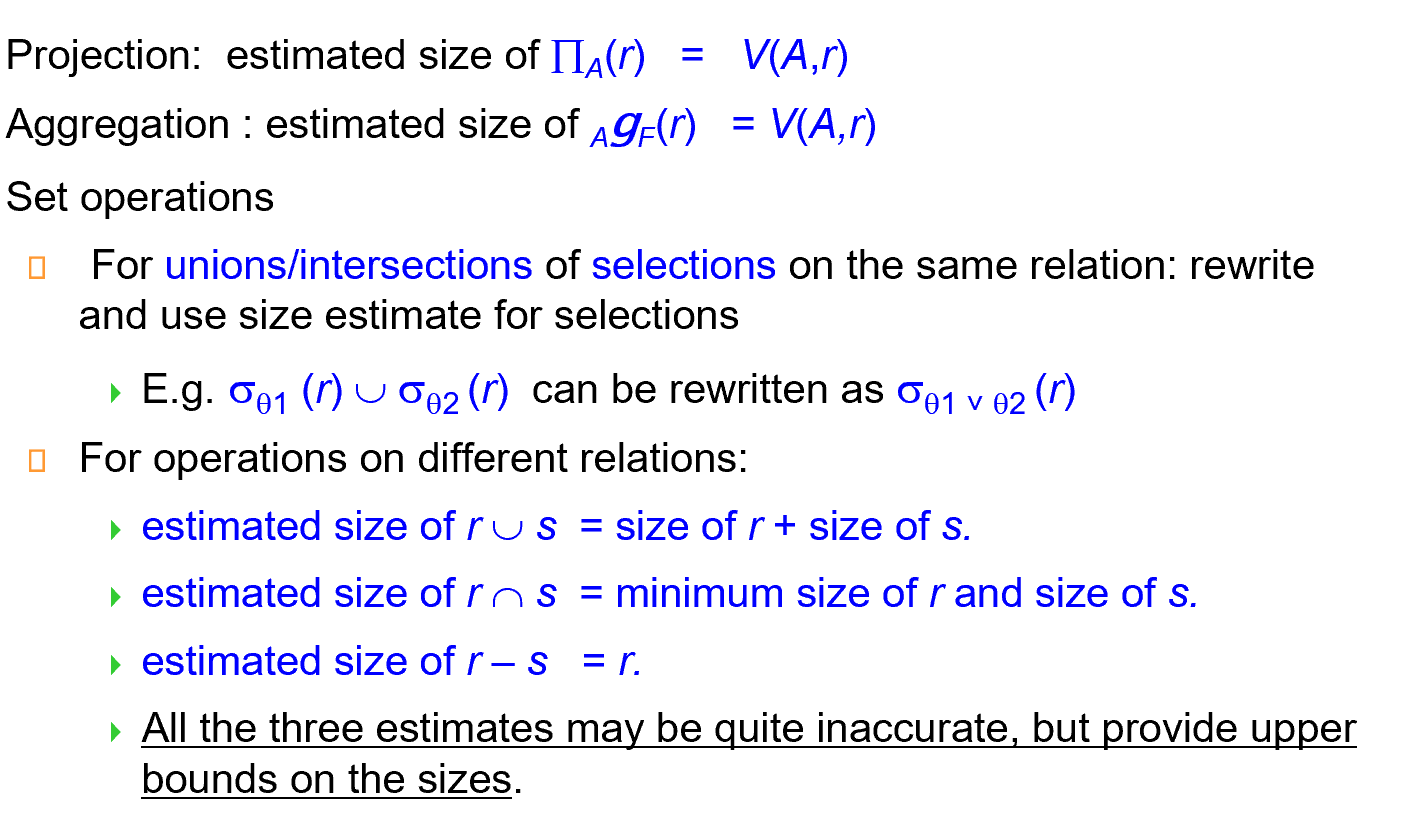
外部连接 r, s 认为是 r s 自然连接的结果加上 r 的大小。
Estimation of Number of Distinct Values#
估算 V(A,r).
Selections \(\sigma_\theta(r)\), estimate \(V(A,\sigma_\theta(r))\)
- If \(\theta\) forces A to take a specified value, \(V(A,\sigma_\theta(r))=1\)
e.g., A = 3 - If \(\theta\) forces A to take on one of a specified set of values: \(V(A,\sigma_\theta(r))=\) number of specified values
e.g., (A = 1 V A = 3 V A = 4) - If the selection condition \(\theta\) is of the form A op v, \(V(A,\sigma_\theta(r))=V(A,r)*s\)
利用选择率 s 计算 - In all the other cases, use approx1imate estimate: \(V(A,\sigma_\theta(r))=\min(V(A,r), \n_{\sigma_\theta(r)})\)
joins \(r\bowtie s\), estimate \(V(A,r\bowtie s)\)
- If all attributes in A are from r, the estimated \(V(A,r\bowtie s)=\min(V(A,r), n_{r\bowtie s})\)
- If A contains attributes A1 from r and A2 from s, then estimated \(V(A,r\bowtie s)=\min(V(A1,r)*V(A2-A1,s), V(A1-A2,r)*V(A2,s), n_{r\bowtie s})\)
Choice of Evaluation Plans#
Must consider the interaction of evaluation techniques when choosing evaluation plans
choosing the cheapest algorithm for each operation independently may not yield best overall algorithm
e.g. merge-join may be costlier than hash-join, but may provide a sorted output which reduces the cost for an outer level aggregation.
Mergejoin 代价高,但是有个好处是 join 后是有次序的,对上层操作有利。
如果要找最优的执行计划,可能需要很长时间。通常按照经验规则。
我们主要考虑连接操作的优化。
Cost-Based Join-Order Selection#
Consider finding the best join-order for \(r_1\bowtie r_2\bowtie \ldots r_n\).
There are \((2(n – 1))!/(n – 1)!\) different join orders for above expression.
Example

Using dynamic programming, the least-cost join order for any subset of \(\{r_1, r_2, \ldots r_n\}\) is computed only once and stored for future use.
Join Order Optimization Algorithm

先分解成两个小的集合 \(S_1, S-S_1\). 递归地细分。
递归到最底层就变为了对单个表的选择方法。
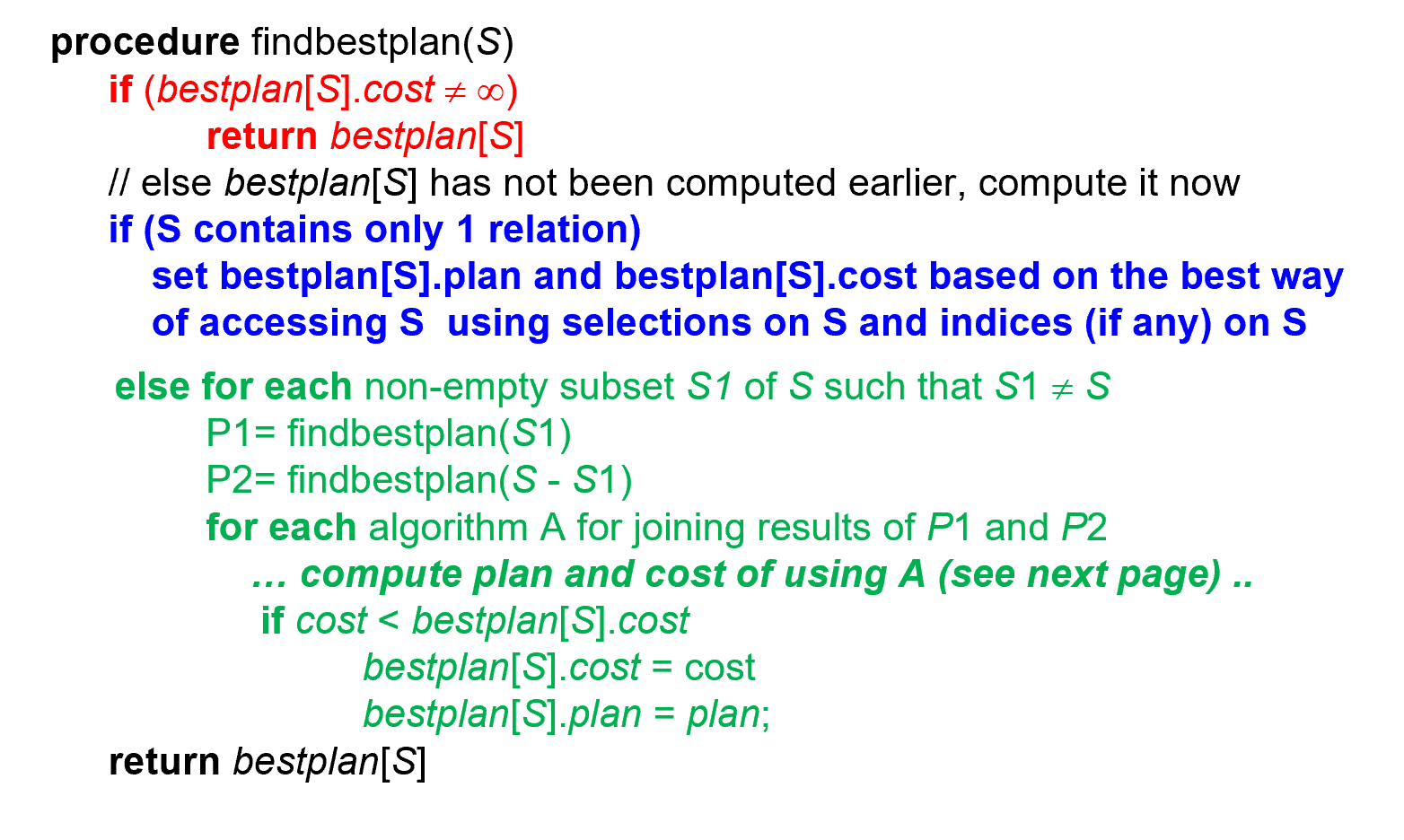
Left Deep Join Trees#
In left-deep join trees, the right-hand-side input for each join is a relation, not the result of an intermediate join.
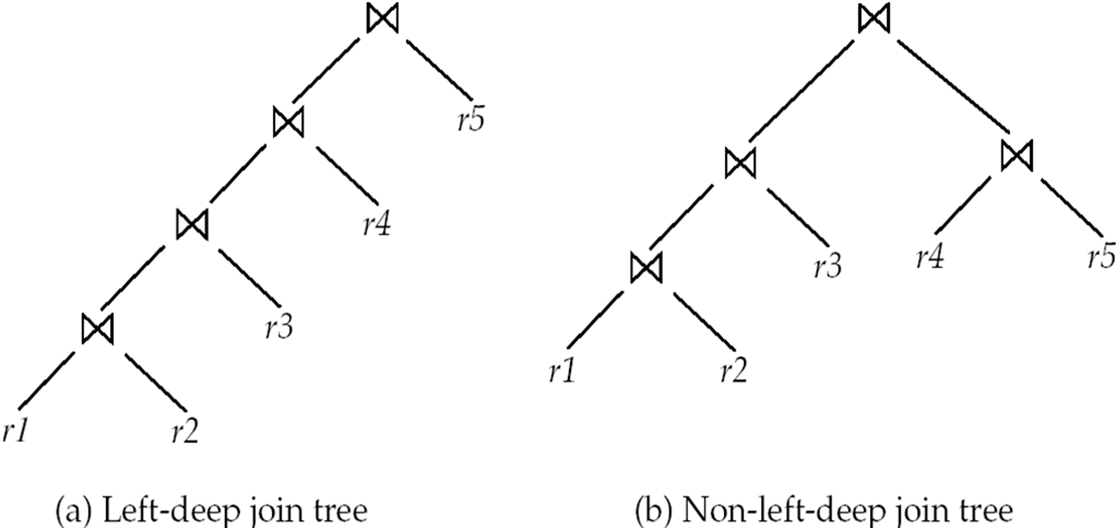
左边可以是中间结果,右边必须是一个关系。
Cost of Optimization#
- With dynamic programming
- time complexity of optimization with bushy trees is \(O(3^n)\).
- Space complexity is \(O(2^n)\)
- left-deep join tree
- Time complexity of finding best join order is \(O(n 2^n)\)
- Space complexity remains at \(O(2^n)\)
Heuristic Optimization#
Cost-based optimization is expensive.
可以用启发式优化
Heuristic optimization transforms the query-tree by using a set of rules that typically (but not in all cases) improve execution performance:
- Perform selection early (reduces the number of tuples)
- Perform projection early (reduces the number of attributes)
- Perform most restrictive selection and join operations (i.e. with smallest result size) before other similar operations.
- Perform left-deep join order
Additional Optimization Techniques#
Nested Subqueries#
Nested query example:
select name from instructor
where exists
(select * from teaches
where instructor.ID = teaches.ID and teaches.year = 2022)
两重循环,但是低效。
Parameters are variables from outer level query that are used in the nested subquery; such variables are called correlation variables(相关变量)
即来自外循环的变量。如果没有相关变量,我们可以先执行内部,然后再执行外部。
把刚刚那个例子改为一个 select 语句,那么一个老师如果开了很多门课就会出现很多个名字。但是加上 distinct 关键词后又无法区分同名情况。
半连接 \(⋉\)_\theta s$,检验 r 是否满足某个关系。
If a tuple \(r_i\) appears n times in r, it appears n times in the result of \(r \(⋉\)_\theta s\) , if there is at least one tuple \(s_i\) in s matching with \(r_i\).
Example
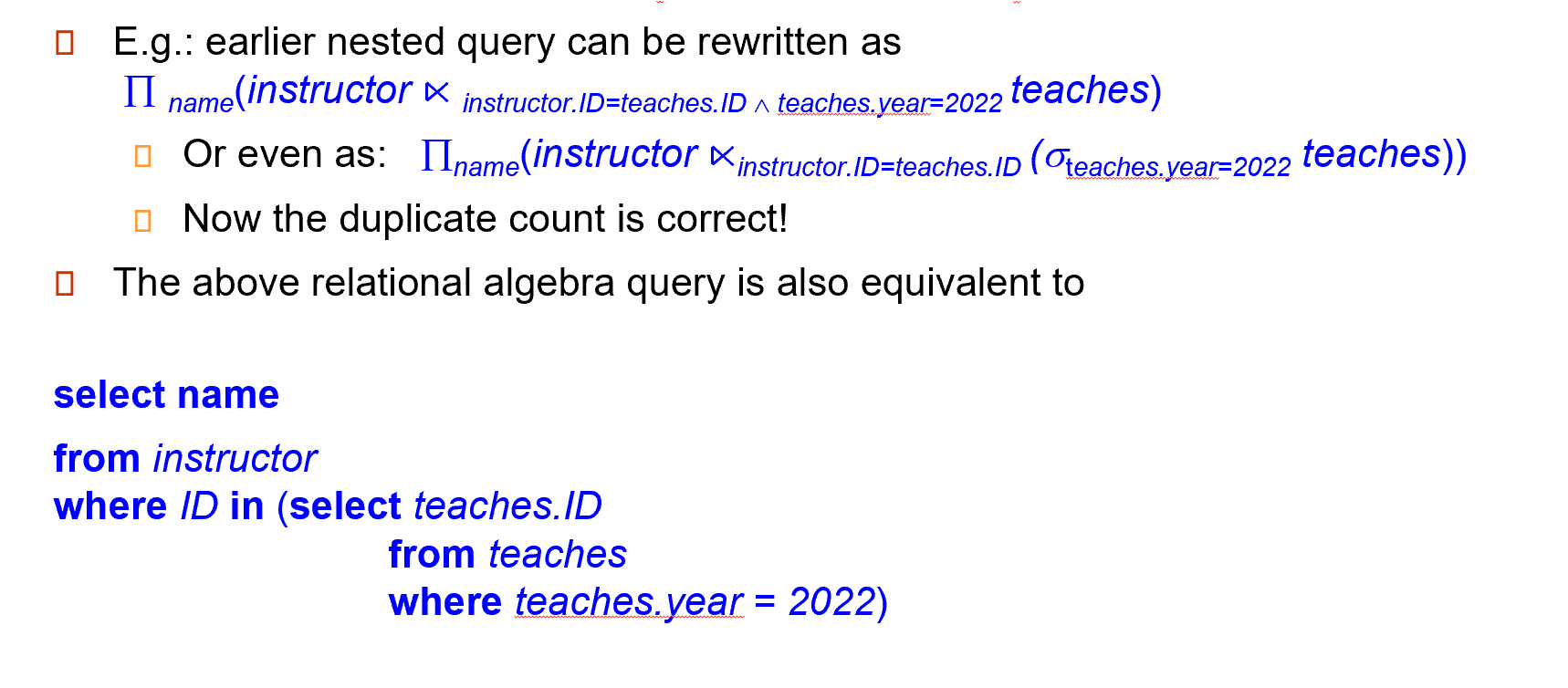

The process of replacing a nested query by a query with a join/semijoin (possibly with a temporary relation) is called decorrelation(去除相关)
Decorrelation of scalar aggregate subqueries can be done using groupby/aggregation in some cases
Example

Materialized Views#
A materialized view is a view whose contents are computed and stored.
有些数据库里把 view 实例化了,真正存储在内部的临时表。
create view department_total_salary(dept_name, total_salary)
as select dept_name, sum(salary) from instructor group by dept_name
Saves the effort of finding multiple tuples and adding up their amounts.
但是需要时刻保持这个视图和原表一致。
use incremental view maintenance(增量视图维护)
The changes (inserts and deletes) to a relation or expressions are referred to as its differential(差分)
-
join: \(V^{new}=V^{old}\cup (i_r\bowtie s), V^{new} = V^{old}-(d_r\bowtie s)\)
join
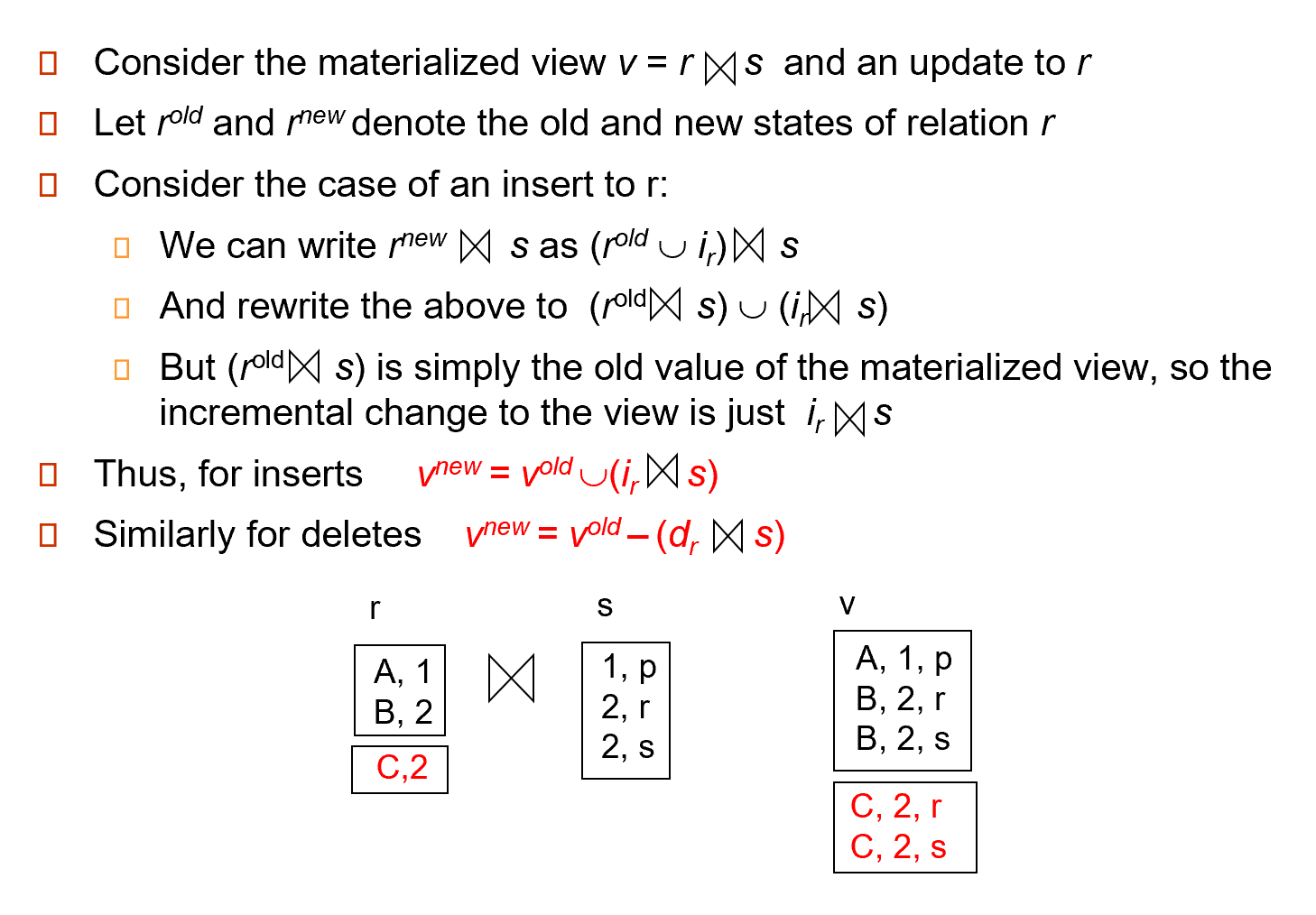
-
select: \(V^{new}=V^{old}\cup \sigma_\theta(i_r), V^{new} = V^{old}-\sigma_\theta(d_r)\)
-
projection:
For each tuple in a projection \(\Pi_A(r)\), we will keep a count of how many times it was derived.- On insert of a tuple to r, if the resultant tuple is already in \(\Pi_A(r)\) we increment its count, else we add a new tuple with count = 1
- On delete of a tuple from r, we decrement the count of the corresponding tuple in \(\Pi_A(r)\) if the count becomes 0, we delete the tuple from \(\Pi_A(r)\)
Projection

-
count \(v= _Ag_{count(B)}\)
- insert: For each tuple r in \(i_r\), if the corresponding group is already present in v, we increment its count, else we add a new tuple with count = 1
- delete: for each tuple t in \(i_r\).we look for the group t.A in v, and subtract 1 from the count for the group.
If the count becomes 0, we delete from v the tuple for the group t.A
-
sum \(v= _Ag_{sum(B)}\)
- min, max
怎么利用这些 view?
-
Rewriting queries to use materialized views:
Example

-
Replacing a use of a materialized view by the view definition
Materialized View Selection
有哪些查询?各种查询的比例?
Created: 2024年3月19日 11:22:29